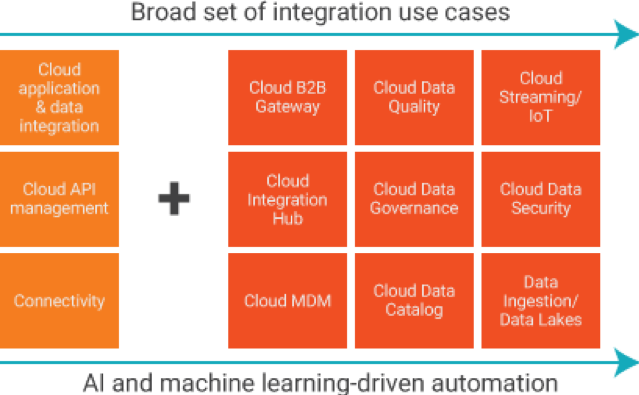Choosing a Hybrid Cloud Integration Solution
Last Published: Mar 18, 2025 |
Good data, cloud computing, and agile, adaptable software: These are must-haves for any modern enterprise that wants to identify new paths and opportunities for growth, detect problems early on, and change directions as necessary based on business or market demands.

Getting data is not the issue; most organizations have tons of data in their databases, applications, IoT streams, and social networks, spread across on-premises and multiple clouds. But how do you get maximum value from all this data while remaining flexible enough to address a wide variety of data-related business problems? You need a hybrid cloud integration platform with multiple cloud integration services—and we’ve got a list of considerations so you can make sure your cloud integration platform covers all the bases.
What is hybrid cloud integration?
A hybrid cloud integration solution helps organizations connect, move, integrate, transform, and manage data across cloud and on-premises. Organizations moving to the cloud are not just modernizing and moving data centers to the cloud, but also re-architecting data warehouses and data lakes for better analytics, business agility, and reduced cost. All of that data needs to be moved, transformed, and made trustworthy. At the same time, metadata (data about data) has become even more important and powerful for delivering the transparency you need to make full use of your data.
Considerations for cloud integration solutions
1. Why does data ingestion matter for cloud integration?
Data ingestion is a critical part of hybrid cloud integration—especially when you have to ingest large amounts of data into data warehouses or data lakes. A good data ingestion solution handles all sources and data types without a lot of manual oversight. It should be able to ingest and orchestrate massive amounts of data in batch or real time from files, databases, and streaming sources (log files, clickstreams, Kafka, IoT devices, and so on) into any target such as data warehouses, data lakes, or messaging hubs/queues.
2. What capabilities do I need for integrating cloud data?
Cloud data integration is the foundation of any hybrid cloud integration platform. A cloud data integration tool should connect to several applications and data sources across on-premises and cloud. Cloud integration software is used by many people outside of IT, especially line-of-business users, so it should be easy to use: Look for drag-and-drop interactive wizards with reusable and shareable features.
If you’re using cloud data integration tools for ETL, they are used to provision data warehouses, so make sure you have out-of-the box connectors to cloud data warehouses like Amazon Redshift, Microsoft Azure SQL Data Warehouse, Google BigQuery, and Snowflake. They should also provide capabilities to synchronize and replicate data.
If you need to process large volumes of big data at scale inside your data lake or data warehouse, you’ll want elastic cloud data integration capabilities. Integration with elasticity is a serverless deployment—just design the data flows and they are automatically executed on the cluster of your choice, with automated scalability. Elastic cloud data integration is important if you plan to take big data workloads to the cloud.
3. What capabilities do I need to integrate applications?
Application integration is another key capability of cloud integration platforms. Integrating applications in real time using process orchestration, APIs, and messaging to propagate data from one data source to another is important. Having the ability to create intelligent APIs that connect lines of business, customers, and partners with applications, process, and data is also important. Your cloud application integration solution should work in multi-cloud and hybrid environments and should be easy for everyone to use, whether they’re in IT or line of business.
The ability to create APIs with no/low-code is critical. APIs play a significant role in extracting IP—be it business logic or data—stored in legacy systems. They are instrumental in ensuring that integration doesn’t become a spaghetti mess but stays flexible and loosely coupled. When secured, managed, and governed properly, these APIs can enable rapid data and application integrations, SaaS integrations, and legacy modernization, and can help companies create opportunities to monetize their IP to find new revenue streams.
4. Can it support my partner management processes?
The old way of managing supply-chain partners with value-added networks (VANs) or legacy on-premises solutions is an outdated 15-year-old technology and is no longer a viable option. The increased speed of business demands faster partner onboarding and management—speed that AI-driven automation and cloud flexibility can deliver. A good cloud integration platform includes cloud B2B capabilities that simplify electronic data interchange (EDI) handling with out-of-the-box EDI processing and validation and comprehensive monitoring and tracking. Add cloud’s lower cost of ownership, recurring automated upgrades, flexibility, and elasticity, plus tools that both IT and non-IT workers can use with ease, and it’s clear that a cloud B2B gateway is an integral part of a hybrid cloud integration platform.
5. How does it manage different latency and self-service requirements?
To get maximum value from your data, you must connect to hundreds of data sources and targets—on premises and in the cloud—with different frequencies, data types, and structures. The point-to-point integration creates a hairball situation: there are simply too many points to effectively manage and change. A modern hybrid cloud integration paradigm featuring a pub/sub architecture can untangle the hairball. A pub/sub architecture offers an integration pattern that will:
- Streamline the complexity of data and application integration in hybrid environments
- Allow IT admins and developers to govern and synchronize data flows
- Enable systems to respond to events in any latency, from real-time streaming to scheduled batch
- Allow IT to enable data democratization and self-service data access to non-developer users within the organization
Why is iPaaS important for hybrid cloud integration?
Think of integration platform as a service (iPaaS) as a cloud-friendly alternative to traditional forms of data integration: you can bring together on-premises and cloud-based applications and data to create a single source of trusted data with less effort and expense. It’s all about democratizing integration from integration experts to citizen integrators and getting value from the platform rather than spending time operating the platform. (Learn more about the iPaaS advantage here.)

iPaaS offers a fully managed service with continuous, automatic system updates in the cloud and eliminates the need of manual upgrades and maintenance of software. A truly next-gen iPaaS should address any data management use case, for any data, and for all types of users for a multi-cloud, hybrid world. It should go beyond the data integration and cloud application management table stakes, building on them to address more complex data integration and connection requirements. And it should address your organization’s current needs as well as be prepared to address future demand as your business changes and grows.
For more on hybrid cloud integration and next-gen iPaaS, check out this eBook on reimagining iPaaS for a data-driven world.








